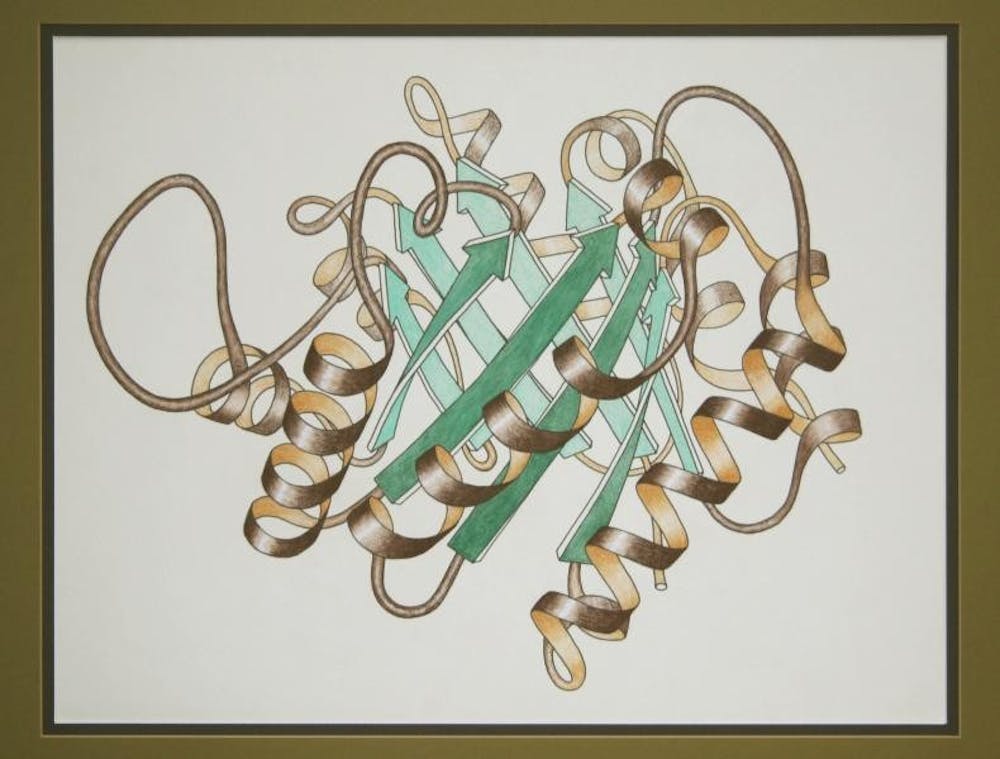If you’ve walked through the Chappell Family gallery in Perkins Library any time recently, you’ve probably noticed it: the big colorful arrows and ribbons on the walls, the twisting wires and strange diagrams galore.
The exhibit, called “Seeing the Invisible: 50 Years of Macromolecule Visualization,” chronicles the development of a key visualization technique in the field of biology. With its grand opening this past Wednesday, Feb 23, the display is centered around the ever-important ribbon model for proteins. If you’ve taken biology classes, then you would surely recognize the model, widely used due to its ability to easily show the α-Helice and β-Strands in the secondary structure of protein molecules.
The exhibit, which replaces last semester’s “Senses of Venice,” focuses on the work of Duke professors and married couple Jane and David Richardson, who pioneered the ribbon model — often called the Richardson model, reflecting how significant their contribution is to the subject.
Jane Richardson, who graduated with a Bachelor’s degree in philosophy from Swarthmore College in 1962 before earning a Master’s degree from Harvard in 1966, took a non-typical route toward science. But even though she may have not followed the traditional path for a biology researcher, her philosophy background was helpful and unique enough.
In a 2018 interview with the Chronicle, Jane said, “[Philosophy] teaches you not just to do critical thinking, but really to push it and always question an assumption.”
However, despite her heavy involvement in philosophy, Richardson had long been interested in science, winning the Westinghouse Science Talent Search in high school for calculating the orbit of the satellite Sputnik. When she joined her husband at an MIT lab, where David Richardson was working toward a doctoral degree, to study staphylococcal nuclease protein with X-ray crystallography, she began a career-long focus on protein structure.
The Richardsons then began trailblazing new frontiers within the discipline. After moving to Duke University in 1970, they found the first crystal structure of the enzyme superoxide dismutase. Without the current-day technology of synchrotrons, or strong sources of X-rays, scientists, including the Richardsons, relied on crystallography. In the following decade, they came up with the first ribbon drawings of the molecule, and by 1981, the first images of her famous ribbon model appeared in an article titled “The anatomy and taxonomy of protein structure,” published in the journal “Advances in Protein Chemistry.”
Creating this model, though, was not easy. It required years of research, and models were constructed in several different mediums, including the wire figures seen around the exhibit and even a wooden design created by a bevel miter saw (which was also used to build their home in the Duke forest). Most influential, though, would be the iconic dual drawings of the Staphylococcal nuclease. In the exhibit, there are both the primary sketch drawn by Jane Richardson and the final pen-and-ink version. She spent an entire year just learning to draw 2-D ribbon drawings that fully represented the entire 3-D protein molecule.
After their breakthrough with the ribbon model, the Richardsons continued to work and excel in the field of biochemistry. In 1985, Jane Richardson received the MacArthur Fellowship, and, even though she may not have completed a PhD degree program, she has been awarded three honorary doctorates over the years from Swarthmore College, the UNC Chapel Hill and the University of Richmond.
Even today, the couple keeps themselves busy. As the two heads of the Richardson lab here at Duke University, they oversee important research in the field of biochemistry. Questions about resolution and computer modeling remain pressing concerns in the Richardson Lab.
Get The Chronicle straight to your inbox
Signup for our weekly newsletter. Cancel at any time.
Jonathan Pertile is a Trinity senior and recess editor of The Chronicle's 118th volume.

